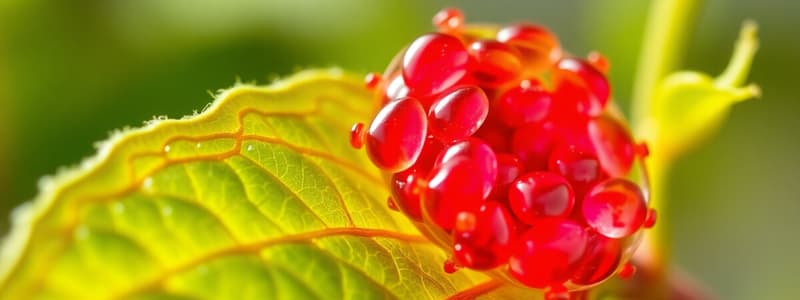Podcast
Questions and Answers
What role does chlorophyll play in plants?
What role does chlorophyll play in plants?
- It aids in asexual reproduction.
- It gives plants their green color. (correct)
- It captures light energy for photosynthesis.
- It stores genetic information.
Which process is described by the production of genetically unique organisms?
Which process is described by the production of genetically unique organisms?
- Fission
- Sexual reproduction (correct)
- Cell division
- Asexual reproduction
What structure is DNA coiled into during cell division?
What structure is DNA coiled into during cell division?
- Nucleus
- Chromosomes (correct)
- Mitochondria
- Chromatin
Which of the following phases is NOT part of the cell cycle?
Which of the following phases is NOT part of the cell cycle?
What is the primary function of chloroplasts in plants?
What is the primary function of chloroplasts in plants?
What is the role of specialized cells and tissues in multicellular organisms?
What is the role of specialized cells and tissues in multicellular organisms?
Which type of organic molecule serves as the primary energy source for the body?
Which type of organic molecule serves as the primary energy source for the body?
Which stage of mitosis involves the alignment of chromosomes along the cell's equator?
Which stage of mitosis involves the alignment of chromosomes along the cell's equator?
What key role do lipids play in multicellular organisms?
What key role do lipids play in multicellular organisms?
What occurs during telophase of mitosis?
What occurs during telophase of mitosis?
Flashcards
Chlorophyll
Chlorophyll
The green pigment found in plants that absorbs sunlight for photosynthesis.
Chloroplast
Chloroplast
Organelles within plant cells that capture light energy during photosynthesis.
Asexual reproduction
Asexual reproduction
A type of reproduction where a single organism produces offspring that are genetically identical to itself.
Sexual reproduction
Sexual reproduction
Signup and view all the flashcards
Cell division
Cell division
Signup and view all the flashcards
Mitosis
Mitosis
Signup and view all the flashcards
Metaphase
Metaphase
Signup and view all the flashcards
Anaphase
Anaphase
Signup and view all the flashcards
Telophase
Telophase
Signup and view all the flashcards
Cytokinesis
Cytokinesis
Signup and view all the flashcards
Study Notes
Plant Pigments
- Chlorophyll is the pigment that makes plants appear green.
Photosynthesis
- Chloroplast absorbs light energy for photosynthesis.
Reproduction
- Asexual reproduction allows organisms to reproduce without a partner.
- Sexual reproduction creates genetically diverse offspring.
DNA Structure
- DNA coils into structures called chromosomes.
Cell Renewal
- Cell division replaces dead cells.
Cell Cycle Stages
- The cell cycle consists of interphase, mitosis, and cytokinesis.
Structure and Function in Multicellular Organisms
- Multicellular organisms are complex, with specialized cells and tissues that work together.
- Cells group into tissues, tissues form organs, and organs form organ systems.
- This structure allows for efficient tasks to be completed.
Organic Molecules and Biological Processes
- Organic molecules, mostly carbon-based, are essential for life.
- Key organic molecules include carbohydrates, lipids, proteins, and nucleic acids.
- Carbohydrates are the body's primary energy source and are important for energy storage.
- Lipids (fats and oils) store energy, insulate, and form cell membranes.
- Proteins have many functions, including support, enzyme action, and transportation.
- Nucleic acids (DNA and RNA) store and transmit genetic information for inheritance and protein synthesis.
PMAT (Mitosis)
- The cell cycle results in a parent cell dividing into two daughter cells.
- PMAT represents the four key stages of mitosis, crucial to the cell cycle.
- Prophase: Chromatin condenses, nuclear envelope disappears, and spindle fibers form.
- Metaphase: Chromosomes line up along the cell's middle (metaphase plate).
- Anaphase: Sister chromatids separate and move to opposite poles.
- Telophase: Chromosomes unwind, new nuclear envelopes form, and the cell begins to divide.
- Cytokinesis: The cytoplasm divides, forming two separate daughter cells; this is distinct from PMAT.
- Mitosis supports cell growth, repair, and asexual reproduction.
Studying That Suits You
Use AI to generate personalized quizzes and flashcards to suit your learning preferences.




